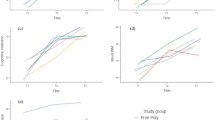Abstract
The aim of this study was to explore the extent to which the characteristics of two teaching interventions can bring about cognitive progress in preschoolers with regard to the factors rolling friction depends on, when it is applied to an object that is freely rolling on a horizontal surface. The study was conducted in three phases: pre-test, teaching intervention, and post-test. Two teaching strategies were compared: one inspired by Piaget’s theory (Piagetian approach) and one inspired by post-Piagetian and Vygotkian assumptions (socio-cognitive approach). A statistically significant difference was found between the pre-test and post-test, providing evidence that the socio-cognitive approach allows for the creation of a more appropriate teaching framework compared to the Piagetian one.


Similar content being viewed by others
References
American Association for the Advancement of Science (AAAS) Project 2061. (1999). Dialogue on early childhood science, mathematics, and technology education. Retrieved December 19, 2006, from http://www.project2061.org/publications/earlychild/online/default.htm.
Conezio, K., & French, L. (2002). Science in the preschool classroom: Capitalizing on children’s fascination with the everyday world to foster language and literacy development. Young Children, 57(5), 12–19.
Crahay, M., & Delhaxhe, A. (1988). Agir avec les rouleaux. Agir avec l’eau. [Act with rollers. Act with water]. Bruxelles, Belgium: Labor.
Doise, W., & Mugny, G. (1984). The social development of the intellect. New York: Pergamon.
Ergazaki, M., Komis, V., & Zogza, V. (2005). High-school students’ reasoning while constructing plant growth models in a computer-supported educational environment. International Journal of Science Education, 27(8), 909–933.
European Commission. (2003). Implementation of “Education and Training 2010” work programme, work group “Increasing participation in math, sciences and technology” (Progress report). Retrieved December 19, 2006, from http://europa.eu.int/comm/education/policies/2010/doc/maths_sciences_en.pdf.
Fleer, M. (1991). Socially constructed learning in early childhood science education. Research in Science Education, 21(1), 132–139.
Fleer, M., & Robbins, J. (2003). Understanding our youngest scientific and technological thinkers: international developments in Early Childhood Science Education. Research in Science Education, 33(4), 399–404.
French Ministry of Education. (2006). Enseignements des Sciences et de la Technologie à l’école. [Teaching science and technology at primary school]. Retrieved December 19, 2006, from http://eduscol.education.fr/D0027/EXSREF02.htm.
Hibon, M. (1996). La Physique est un jeu d’enfant. [Physics is a child’s play]. Paris: A. Colin.
Howe, A. (1993). Science in Early Childhood Education. In B. Spodek (Ed.), Handbook of research on the education of young children (pp. 225–235). New York: McMillan.
Inagaki, K. (1992). Piagetian and post-Piagetian conceptions of development and their implications for Science Education in early childhood. Early Childhood Research Quarterly, 7(1), 115–133.
Kamii, C. (1982). La connaissance physique et le nombre à l’école enfantine. Approche piagétienne. [Physical knowledge and the number in preschool education. Piagetian approach]. Genève, Switzerland: Université de Genève.
Kamii, C., & De Vries, R. (1978). Physical knowledge in preschool education: Implications of Piaget’s theory. Englewood Cliffs, New Jersey: Prentice Hall.
Kamii, C., & De Vries, R. (1993). Physical knowledge in preschool education: Implications of Piaget’s theory. New York: Teachers College Press.
Kampeza, M. (2006). Preschool children’s ideas about the Earth as a cosmic body and the day/night cycle. Journal of Science Education, 5(1), 119–122.
Kanari, Z., & Millar, R. (2004). Reasoning from data: How students collect and interpret data in science investigations. Journal of Research in Science Teaching, 41(7), 748–769.
Koliopoulos, D., Tantaros, S., Papandreou, M., & Ravanis, K. (2004). Preschool children’s ideas about floating: a qualitative approach. Journal of Science Education, 5(1), 21–24.
Lemeignan, G., & Weil-Barais, A. (1993). Construire des concepts en Physique. [Constructing concepts in Physics]. Paris: Hachette.
Martinand, J.-L. (1986). Connaître et transformer la matière. [Knowing and transforming matter]. Berne, Switzerland: Peter Lang.
Metz, K. (1995). Reassessment of developmental constraints on children’s science instruction. Review of Educational Research, 65(2), 93–127.
Paulu, N., & Martin, M. (1992). Helping your child learn science. Washington: U.S. Department of Education.
Ravanis, K. (1994). The discovery of elementary magnetic properties in pre-school age. A qualitative and quantitative research within a Piagetian framework. European Early Childhood Education Research Journal, 2(2), 79–91.
Ravanis, K. (2005). Les Sciences Physiques à l’école maternelle: éléments théoriques d’un cadre sociocognitif pour la construction des connaissances et/ou le développements des activités didactiques. [Natural sciences in kindergarten: A socio-cognitive framework for learning and teaching]. International Review of Education, 51(2/3), 201–218.
Ravanis, K., & Bagakis, G. (1998). Science education in kindergarten: sociocognitive perspective. International Journal of Early Years Education, 6(3), 315–327.
Ravanis, K., Koliopoulos, D., & Hadzigeorgiou, Y. (2004). What factors does friction depend on? A socio-cognitive teaching intervention with young children. International Journal of Science Education, 26(8), 997–1007.
Robbins, J. (2005). Contexts, collaboration, and cultural tools: a sociocultural perspective on researching children’s thinking. Contemporary Issues in Early Childhood, 6(2), 140–149.
Rogoff, B. (1990). Apprenticeship in thinking: Cognitive development in social context. New York: Oxford University Press.
Stead, K., & Osborne, R. (1981). What is friction? Some children’s ideas. Australian Science Teachers Journal, 27(3), 310–329.
Tsagliotis, N. (1997). Aspects of conceptual change of 10–11 year-old children in England and in Greece: the concept of frictional force. Unpublished M.Phil. Thesis, Nottingham Trent University, Nottingham, UK.
Vygotsky, L. S. (1962). Thought and language. Cambridge, MA: MIT Press.
Weil-Barais, A. (2001). Constructivist approaches and the teaching of science. Prospects, 31(2), 187–196.
Zogza, V., & Papamicael, Y. (2000). The development of the concept of alive by preschoolers through a cognitive conflict teaching intervention. European Journal of Psychology of Education, 15(2), 191–205.
Author information
Authors and Affiliations
Corresponding author
Rights and permissions
About this article
Cite this article
Ravanis, K., Koliopoulos, D. & Boilevin, JM. Construction of a Precursor Model for the Concept of Rolling Friction in the Thought of Preschool Age Children: A Socio-cognitive Teaching Intervention. Res Sci Educ 38, 421–434 (2008). https://doi.org/10.1007/s11165-007-9056-7
Received:
Accepted:
Published:
Issue Date:
DOI: https://doi.org/10.1007/s11165-007-9056-7




